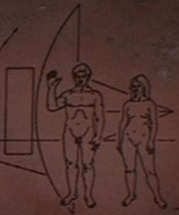(cut the pictures too. At the end of the day they just aren't relevant to the topic of mating. Put the best pic I could think of up instead) |
|||
| Line 35: | Line 35: | ||
=== More then two sexes or genders === |
=== More then two sexes or genders === |
||
| − | Some species had more than two sexes, or different capacities were assumed by sexes not conforming to the pattern of male/female bonding which seemed to be common throughout [[Milky Way Galaxy|the galaxy]]. |
+ | Some species had more than two sexes, or different capacities were assumed by sexes not conforming to the pattern of male/female bonding which seemed to be common throughout [[Milky Way Galaxy|the galaxy]]. Tri-gender reproduction was not uncommon. ({{ENT|Cogenitor}}) |
[[Vissian]]s required three separate sexes to reproduce: Male, Female, and a [[Cogenitor]] who served as a catalyst for the fertility of the female. ({{ENT|Cogenitor}}) |
[[Vissian]]s required three separate sexes to reproduce: Male, Female, and a [[Cogenitor]] who served as a catalyst for the fertility of the female. ({{ENT|Cogenitor}}) |
||
Revision as of 20:24, 19 August 2014

Human male and female contrasted
"In spite of Human evolution, there are still some traits that are endemic to gender."
Genders (or sexes) were a type of biological variation between different members of the species. They were key to sexual reproduction, the creation of offspring. In many humanoid species, this involved a combination of two or more individuals' genetic material. It was also possible for members of certain species with compatible or related genetic structures to practice inter-species reproduction.
Certain cultures facilitated this bonding with some form of a wedding ceremony.
In many animal species, the female initiated the mating ritual. Captain Janeway reminded Tom Paris of this when they hyper-evolved into salamander-like species and produced offspring. (VOY: "Threshold")
Male and female gender
Many humanoid cultures had a two-sex system based around around the division between male and female. Biologically, the male added a genetic seed to be combined with the female's genetic seed in a process called sexual reproduction.
Some more advanced lifeforms also maintained such distinctions. When two members of the Q Continuum chose to practice two-party reproduction, they manifested themselves in such a manner. (VOY: "The Q and the Grey") However, Q revealed a scornful attitude toward human females when he discovered Humans in the Delta Quadrant a century sooner than expected: "This is what happens when you put a woman in the Captain's chair!" (VOY: "Death Wish")
Gender roles in Humans
William T. Riker referred to an Earth nursery rhyme, "What Are Little Boys Made Of?", which stated: "Girls are made from sugar and spice, boys are made from snips and snails... and puppy dog tails," to describe the "old-fashioned way of looking at the sexes" to the androgynous Soren. He later clarified that "physically, men are bigger, stronger" and that they "have different sexual organs". He also noted that "men can't bear young." (TNG: "The Outcast")
Worf once explained that it was his understanding that "in most Human families, the woman shares in the cooking." (TNG: "Time Squared")
Other variants of sex and gender
There were also various alien sexual makeups which consisted of different constructs or combinations of sexes:
Androgynous species
- See: Androgyny
Androgyny was was absence of distinct genders. A number of androgynous species were known, including the Axanar, Xindi-Insectoids, Jem'Hadar, and more.
Hermaphroditic and transgendered species
- see: Hermaphrodite
Hermaphrodism refered to having two or more sexual characteristics or biological functions combined. Unlike the androgynous, hermaphrodites had the capability of being male or female during a sexual process, or undergoing a functional transformation from one gender to another.
During the wedding ceremony of William T. Riker and Deanna Troi, Data also welcomed the invited transgendered species. (Star Trek Nemesis)
More then two sexes or genders
Some species had more than two sexes, or different capacities were assumed by sexes not conforming to the pattern of male/female bonding which seemed to be common throughout the galaxy. Tri-gender reproduction was not uncommon. (ENT: "Cogenitor")
Vissians required three separate sexes to reproduce: Male, Female, and a Cogenitor who served as a catalyst for the fertility of the female. (ENT: "Cogenitor")
Species 8472 had as many as five sexes, and Doctor Phlox believed Rigelians to have four or five genders. (VOY: "Someone to Watch Over Me"; ENT: "Cogenitor")
Appendices
See also
- Reproductive system (Anatomy)
Background information
The United States of America, like other western cultures, has a history believing women to be less suitable for certain functions. Star Trek: The Original Series is widely known for helping break this pattern by being the first show to portray women (of different races, no less) working alongside men in service.
Kate Mulgrew as Captain Janeway was the first female lead actor of a Star Trek series. The first female Captain seen on Star Trek was the Saratoga captain seen in Star Trek IV: The Voyage Home, played by Madge Sinclair. While Majel Barrett's character Number One may have been the first female first officer to appear in Star Trek, it was Nana Visitor's character, Kira Nerys, who was heralded in the media as being Star Trek's first female regular character to serve as first officer.
According to TNG: "Data's Day" and DS9: "Field of Fire", Andorian marriages typically involved four partners and Bolian marriages might include co-spouses. It was not revealed what, if anything, this said about the genders of the aforementioned species. Several non-canon novels and comics (such as the DS9 series) have portrayed Andorians as having four distinct sexes required for mating; however, only male and female Andorians have been referred to on screen, and no on screen Andorian child has been referred to as having more than two parents. Other novels portray other cultures having three or more sexes, such as Diane Duane's description of a Horta character as being an "orthomale type B4-A".
